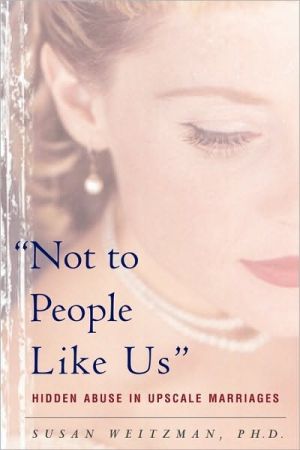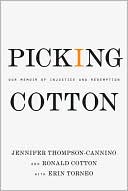Not to People Like Us: Hidden Abuse in Upscale Marriages
How is it possible for a highly educated woman with a career and resources of her own to stay in a marriage with an abusive husband? How can a man be considered a pillar of his community and regularly give his wife a black eye? The very nature of these questions proves how convinced we are that domestic violence is restricted to the lower classes. Now Susan Weitzman explores a heretofore overlooked population of battered wives-the upper-educated and upper-income women who rarely report abuse...
Search in google:
As seen on "2020," "48 Hours," "Sally Jesse Raphael," and in People magazine: A startling exposé of domestic violence against well-educated, well-to-do women, and a powerful indictment of the social service system that fails to protect them. READINGS All practitioners working with adult women should read this book.
\ \ \ \ Chapter One\ \ \ Piercing the Veil of Silence\ \ \ Sally, a pretty, educated, forty-eight-year-old homemaker, had told no one about the violence that existed within her seemingly happy marriage. When I first met her, she was stylishly dressed in a tailored navy pantsuit and white silk blouse, with spectator pumps and handbag to match. Tiny diamond earrings glinted beneath her flowing blond hair. A heavy gold bracelet and a remarkable string of black pearls completed the picture of a woman of substantial means.\ But all was not well in Sally's world. Married to Ray, a highly successful businessman, she gave elegant dinner parties only to be brutally beaten afterwards for offering some of her husband's favorite dessert for admiring guests to take home. Known for her culinary skills and ability to entertain graciously, she wryly commented on her husband's post-party attack: "This is not what Martha Stewart would have had in mind."\ When I met and interviewed Sally during her divorce, the facade of civility and upper-class life behind which she had been hiding had already begun to crumble. Her blue eyes brimmed with tears as she told me that she had sustained a broken jaw and severe and permanent hearing damage as a result of her husband's rages during twenty years of marriage. A large man, he would throw her to the ground and lie on top of her, screaming obscenities directly into her ear when he was displeased with her—which seemed to be much of the time—and that was just part of her "punishment." At various times during their marriage, he had dragged her by the hair, thrown furniture at her, choked her to within moments of her life, banged her head against the walls and floor, and punched her. With a trembling hand, Sally pulled back her carefully arranged coif to show me a misshapen lower jaw, the remnants of a beating she had sustained several months before. Her sad face was no longer symmetrical.\ The physical abuse often followed emotional abuse—tirades and put-downs that left Sally feeling worthless. Ray had had several affairs with other women and had neglected and rejected her and their children. He had humiliated Sally in front of others and consistently blamed her for the violent incidents. "It was always my fault," she explained to me tearfully. "I provoked him. It was because of what I had done. And he never apologized. Never once during all of the abuse did he ever apologize. He never bought me anything to make up for the hurt he caused me. He was never, ever remorseful. It was always him trying to maintain control and make it seem as if it was all my fault. And you know, for a long time, I believed him. Somehow I thought it was my fault.\ "But once our youngest child left for college," Sally continued, "I was terrified. He kept threatening me. I felt like an animal—like I was being kept in a cage in my own home. `I'm going to get you,' he kept saying under his breath. `Now I'm really going to get you. And there won't be anyone here to stop me.'"\ Yet no one except her children (who had witnessed only a few of the physical and emotional attacks) knew about the abuse until after Sally filed for divorce. Not once had she called the police to report the attacks. Everyone thought that Sally and Ray had a good marriage. But within their large and magnificently appointed home, the site of the fabulous dinner events Sally staged, existed a brutal and life-threatening truth that Sally had kept hidden. It was the jarring finality of her physical losses, which she had to accept when her doctor informed her that the damage to her eardrum and jaw were irreversible, that motivated Sally to get out, get help, and "go public" about the secret torture she had tolerated for far too long.\ \ \ THE HIDDEN VICTIMS\ \ \ When we think of love and marriage, we do not think about domestic violence. Moonlight and roses are not supposed to turn into beatings and threats upon one's life. Yet, four million women nationwide are victims of domestic violence per year. Every twelve seconds a woman suffers this sort of abuse at the hands of a husband or lover.\ And when we think of domestic violence, we do not think about women of means. Despite occasional sensational news stories of upscale or celebrity women falling prey to a maniacal mate—Tina Turner, for example, or Pamela Anderson—the public overwhelmingly assumes that domestic violence is confined to couples with little education and few resources. And unfortunately most statistics support this belief.\ Evidence gathered by domestic violence experts indicates that although domestic abuse is not restricted by social class, there is a higher incidence of it in lower socioeconomic groups. In a 1986 review of all the research on domestic abuse, Michigan psychologist Lewis Okun, author of Woman Abuse: Facts Replacing Myths, found that most studies seem to establish a relationship between lower-class status and a greater tendency to report conjugal violence. In his highly cited 1972 book, The Violent Home, sociologist Richard J. Gelles, now at the University of Pennsylvania, reported 82 percent of violent husbands were of lower occupational status than their nonviolent male neighbors. His research also disclosed that wife abuse was highest among men with some high school education and then steadily decreased at higher levels of education, with an overall trend showing violent men to be less educated than their non-abusive counterparts.\ In a more recent research effort, Gelles and his colleague Murray Straus at the University of New Hampshire found that lower socioeconomic groups are "as expected, more violent. The assault rate of blue-collar husbands is 70 percent greater than the assault rate of the white-collar employed husbands." If the combined income of the couple was $9,000 or less, the rate of assault by husbands on their wives was 368 percent higher than in families with a more adequate income. Lastly, and by dramatic contrast to those figures, percentages gathered in the U.S. Department of Justice's Criminal Statistics Sourcebook suggest that in only 8 percent of reported cases of domestic attacks by a spouse or romantic companion, the income level is greater than $75,000 per year.\ These numbers seem convincing, but from my experience they don't tell the whole story. Most of these findings have been based on research on lower-income battered wives. These are the women who call the police and seek refuge in battered women's shelters. But there is a hidden population of wives whose abuse is not studied—women, who for reasons I will make clear, do not report the tirades and tantrums, who refuse to press charges or even call the police despite the broken bones and blackened eyes inflicted on them by the men who purport to love them.\ In this book I describe many other women like Sally, women whose suffering has largely gone unheralded and remains misunderstood. Middle and upper-class women—the wives and lovers of successful, even prominent men—have rarely been studied as victims of abuse. Indeed, it is widely believed that such women, usually well-educated with successful careers of their own, have enough money and power to extricate themselves from potentially harmful domestic situations. As a result of this belief, and the surprising fact that these women tend not to report the abuse or opt to sustain many years of mistreatment before they do, their numbers have been largely absent from the research statistics. This absence, I believe, has skewed society's perception of who exactly becomes an "abused wife."\ \ \ LEARNING THE SECRETS\ \ \ As a mental health professional with twenty-three years of practice experience and fourteen years of teaching experience, I first encountered domestic abuse among the upper echelons of society in my practice at the University of Chicago Hospital's Department of Outpatient Psychiatry. Many of the women I was treating were doctors' wives, professors' wives, and doctors and professors themselves. Some were married to successful businessmen. They were all highly educated, enjoyed comfortable, even lavish lifestyles, and associated with people who were much like themselves.\ These women sought psychotherapy for a range of typical complaints: Some were anxious or depressed; others talked vaguely of "trouble" with their husbands. Many were bored, several complained of self-esteem issues, and some simply said they were "unhappy." But regardless of their diagnoses, I began to discern a common thread in their life stories, a thread that astonished me. Nothing in my training had prepared me for the fact that I would find that more than 50 percent of my patients were enduring emotional and physical abuse at the hands and whims of their powerful and well-educated husbands. Equally disturbing, these women felt it essential to keep silent about their suffering in order "to preserve and protect personal life." This imperative may be found within the makeup of many women in our society. Only with the greatest reluctance did the women I worked with reveal the abuse they had suffered, even within the safe confines of my office.\ As time passed, I learned that my experience was not an isolated one. When I lectured on the subject around the country, I discovered that there was tremendous interest in abuse in this population. Hundreds of people were encountering or experiencing violence in upscale marriages but did not quite know how to understand it, categorize it, or deal with it.\ When I spoke to professional groups, therapists would crowd around the lectern afterward to tell me that they, too, were seeing domestic abuse in their client populations but didn't realize the breadth of its occurrence. They were unsure how to proceed, and complained that the existing literature didn't seem to fit the patients they were treating. Perhaps even more surprising, just as many would approach me privately following a lecture and in a whisper tell me about their own experiences. They wondered what help might be available and whether their predicaments were unique or similar to those of patients I had treated.\ \ \ THE CONTROVERSY\ \ \ It seemed clear to me that I had identified a population that was crying out to be served. Yet at the same time my news was greeted with antagonism and opposition at these very same professional meetings. Many audience members would challenge and confront me. "Why are these women any different from other abused women of lesser educational levels and financial statuses?" they would demand. I was surprised by their hostile tone, betraying both anger and ambivalence at the prospect of learning more about abuse among the educated well-to-do.\ At an international conference, a female social worker staged a vitriolic argument with me during my lecture. She kept raising her hand and interrupting explosively with comments such as: "But why should we give these women special favors? They aren't any better! They don't deserve even more privileges than they already have! The women I work with don't have roofs over their heads ... what have your women got to complain about?"\ Before I could answer, another social worker in the audience meekly raised her hand and responded for me. She turned to the first woman and said, "I was in a very wealthy marriage. And my doctor-husband battered me constantly. I was ashamed and embarrassed. As a mental health professional, I felt I should have known better. I felt I should be able to fix it myself. And I was sure this wasn't happening to anyone I knew. I felt frightened, depressed, and alone. In fact, because of my reputation in the community as well as my husband's position, I really had nowhere to go for help. I actually had less access to help than women less privileged. I'm grateful that someone is finally bringing this problem to light."\ Why did the first social worker have such an extreme response to my talk? Why was one part of my audience responding with relief but another with resistance and consternation? I believe these strong responses reflect not only envy of those with wealth but also the controversial nature of exposing abuse among the educated and upper-income segments of our society. It flies in the face of the widely held myth that abuse doesn't happen to "people like us"—and this threatens a status quo and comfort zone that many of us choose to live in.\ The combination of strong responses from my audiences, my increased awareness of abuse among my middle- and upper-income patients, and the sudden emergence in the media of high-profile cases of domestic violence led me to believe I was onto something that begged for in-depth exploration. News of domestic abuse in the lives of celebrities like Darryl Hannah and Melissa Rivers began to surface in the early 1990s. I embarked on an intensive course of study. By the time I was well into my research, the apparent domestic abuse of Nicole Brown Simpson by her then-husband, O. J. Simpson, so graphically explored and widely reported during his 1995 trial for her murder, placed conjugal abuse among the upper classes squarely in the public spotlight.\ \ \ HOW THE CONSPIRACY OF SILENCE IS REINFORCED\ \ \ Why was this group of battered women so under-represented in the social work and psychological literature? One significant reason is that these women are reluctant to seek help. They buy into the myth that domestic violence afflicts only the underprivileged. The myth becomes a type of institutionalized oppression for the upscale. If a culture's tribal rules deny a phenomenon, then it is truly bound to silence. This veil of silence imbues battered upscale women with self-blame and shame—"I must be the only person like me who is going through this"—further reinforcing their sense of desperate isolation. Also contributing to the problem is the well-documented observation that the upper-middle classes are taught that it is inappropriate to involve the police in "personal problems." A New York City suburban field study concluded that "spouse assault by wealthy and powerful men rarely leads to police intervention." The same study remarked that in more prosperous neighborhoods, spacious homes and large lots made it unlikely that neighbors or friends would learn about and report the abuse. Without such legal reports, the number of abused well-to-do women has gone unnoticed.\ The man of means has more resources to protect his rights, his privacy, and his "castle." Expansive living quarters are not merely luxurious; they also make for an insulated existence, affording more privacy for engaging in physical and emotional tyranny. And on the rare occasion when the battered wife involves the police or other outside authorities, the upscale husband can retain skilled legal representation to defend his actions with little retribution or fanfare.\ The problem is further compounded by society's response. In case after case that I encountered, both in my private practice and while conducting research, when these women do seek assistance from the police, in the courts, from therapists, and even from counselors in women's shelters, they tend to be rejected by the very systems designed to help battered women.\ Take Sherry, a thirty-four-year-old attorney who was in the throes of an abusive relationship from which she was trying to extricate herself. She was too embarrassed to tell any of her friends about her husband's mental torment, so she sought help through a Chicago crisis center for abused women that offered counseling and legal referrals to women of all economic ranks. She chose not to seek a private therapist because she thought that professionals who specifically deal with domestic violence might better serve her. When the intake worker heard her story on the phone and assessed her social situation (that is, she had a home, friends, and was well paid), she told Sherry that she would be put on a waiting list to see a counselor. Understanding the crisis center's need to triage and provide help first to those women in the most immediate danger, Sherry waited.\ But over several weeks her situation worsened. Sherry called the center again, wondering when she would be able to talk with someone. The next worker she spoke to treated her rudely. "Everyone has to wait," this worker snapped at Sherry before she hung up. Sherry called again a week later, requesting the original worker, and politely though firmly inquired how long the expected wait would be before she could see a counselor. In this phone call, she was curtly told that the staff workers were advised specifically not to speak with her on the phone anymore (for no stated or apparent reason) but to just inform her that she would be called when her name came up on the list.\ This was devastating. Sherry was shocked and felt ostracized for no good reason. She wondered if she had demanded too much (she had not) and felt utterly shamed and alone. She even questioned whether her desire to get help was warranted, in light of how she had so readily been ignored and rebuffed by an agency that purported to help abused women. Was her situation less real or serious? As of this writing, it has been more than four years since Sherry's initial call to that center, and an intake counselor has yet to contact her.\ The fact is, upscale abused wives are treated differently from other women. Their complaints may be taken lightly—after all, these women do have roofs over their heads and usually pretty nice ones at that. It is not uncommon for a policeman encountering an expensively dressed woman in her well-appointed home to assume that she has the resources to take care of herself—even though her husband may control all of the credit cards and bank accounts and may have brainwashed her into believing that she and their children would not survive in the world without him.\ One woman I worked with, Jennifer, a successful psychotherapist married to a Harvard graduate attorney, told me of her encounter with the police that had occurred the day after an especially brutal fight with her husband. She had requested police protection when she went back to their penthouse apartment to retrieve some of her belongings. During the long elevator ride with two officers, one of them, observing the scars on her face and her sprained arm, said, "So, honey, with a rich guy like yours, what did you do to get him this mad at you?"\ Before Jennifer could gather her thoughts to reply, the other officer said, in what he obviously meant to be a supportive tone, "Well, at least he didn't kill you." Such joviality in response to an upscale battered woman's crisis is merely one type of re-victimization that she may encounter from professionals.\ Alternatively, her injuries may be ignored or overlooked by professionals who are unaware of domestic abuse among the upscale or are afraid to intervene in such cases. Some professionals fear reprisal for being too intrusive from their patients and the community in which they practice. One study found that in 40 percent of the cases where physicians interacted with battered women in an emergency room setting, the physicians made no response to the abuse. In another emergency department that had established a protocol for domestic violence, physicians failed to give any referral or follow-up for abuse in 92 percent of the domestic violence cases. And while these studies did not specifically track any particular income groups, imagine what the statistics would be if the focus were solely on women of means. Perhaps there would be even fewer referrals and responses!\ Joan, a physician I know, went alone to the emergency room of a major Chicago teaching hospital late on a Saturday night after an intense fight with her husband. Enraged with her for making plans to visit her mother on the weekend, Joan's husband smashed some of her prized glass sculptures against a wall, and one of the larger pieces became deeply embedded in her arm. As the plastic surgery resident removed the glass and stitched up Joan's arm, he never once inquired beyond the story she told him: "I was lifting a glass table top and it dropped." Although her face was tear-stained and she was visibly shaken, Joan was well dressed and a professional. No one in the ER made any additional inquiry, despite the telltale signs of potential abuse. Nor was she given any domestic abuse referral numbers, even as a precaution.\ Some months later, I asked the director of this ER about the handling of spousal abuse in general terms. He said, "Sometimes the ER staff assumes that if it's a case of domestic violence, a woman will volunteer that information. And, you know, we walk a thin line. We don't want to offend someone who is professional by asking."\ What does the emergency room staff fear? Are they overly concerned about being invasive and offensive as the ER chief suggests? Do they fear litigation on the part of the abused woman if they inquire about violence in her home? Or do these professionals simply buy into the myth that abuse doesn't happen to "people like us"? Indeed, some professionals are unwilling to accept the reality of violent behavior among people of their own social class, or they wrongly assume that because of her material advantages the upscale abused woman needs little help in extricating herself from or at least coping with an abusive situation. They readily believe the facile explanations about bruises and injuries when an upscale battered wife offers them.\ (Continues...)\ \ \ Excerpted from "Not to People Like Us" by Susan Weitzman. Copyright © 2000 by Susan Weitzman. Excerpted by permission. All rights reserved. No part of this excerpt may be reproduced or reprinted without permission in writing from the publisher. \ \ \ \
AcknowledgmentsvPart 1Upscale Violence1Piercing the Veil of Silence32"This Doesn't Happen to People Like Us ..."173Why Do Women Stay in Abusive Marriages?37Part 2The Wife's Path in and Her Way Out4Getting In: "He Was So Sexy, So Powerful--He Swept Me Off My Feet ..."555Staying the Course: "I Made My Bed ..."796Going Public and Getting Going: "I'm Outta Here ..."109Part 3People Along the Path: Those Who Help or Hurt7The Men: Arrogance and Insecurity, Grandiosity and Self-Doubt1318What About the Children?1599Who Can Help? Therapeutic Interventions17510The Double-Edged Sword: How Family, Friends, and Professionals Can Make Matters Worse203Part 4Aftermath11Life Goes On221Appendices231Notes253References271Index281
\ Marcia ClarkWritten in a voice that is both compassionate and uncompromising, 'Not to People Like Us' is sure to become the definitive work on the topic of upscale domestic abuse.\ \ \ \ \ READINGSAll practitioners working with adult women should read this book.\ \ \ Publishers WeeklyChicago's affluent North Shore provides 20-year veteran psychotherapist Weitzman with abundant evidence of the secret lives of "upscale domestic abusers" and their victim-wives. Shattering the cultural myth that emotional and physical violence in the home is confined to couples of a lower socioeconomic class, the author presents vivid case histories that are often excluded from clinical studies and statistics. Lacking a frame of reference for domestic violence in this echelon, health-care professionals ignore the signs, while law enforcement agents and judges go easy on it, she contends. Few believe or sympathize with a well-dressed, bejeweled woman if she finds the courage and self-respect to speak out against her successful, respected, powerful and often charming husband, while battered women's shelters turn her away, assuming that she has many other resources. But according to Weitzman, she doesn't. While often well educated and successful, the "upscale abused woman" is typically ignorant of her legal rights, convinced by her abuser that she is responsible for his behavior and isolated by her denial and shame from validating voices and potential assistance. Weitzman's upscale abuser exhibits Narcissistic Personality Disorder, feels eminently entitled and is incapable of seeing his wife as a person in her own right. Weitzman provides excellent practical advice for these women to make choices that extricate them from abuse, and proposes a new language and better education regarding "upscale violence" for the professionals who are likely to see it in their work. (Nov.) Copyright 2000 Cahners Business Information.\ \ \ \ \ Library JournalDrawing on her own research with 14 women aged 24-62, psychotherapist Weitzman exposes abuse among the wealthy. She profiles seemingly unlikely abusers and shows how traditional helping institutions often trivialize this problem and fail its often-misunderstood victims. Copyright 2004 Reed Business Information.\ \ \ \ \ BooknewsBased on her experience as a psychotherapist with the "hidden victims" of domestic abuse in upper-class marriages, Weitzman (lecturer, social work administration, U. of Chicago) provides insights into why they remain in such relationships; how the profile of abused and abuser differs from those in other socioeconomic classes; and early warning signs, interventions, and resources. Annotation c. Book News, Inc., Portland, OR (booknews.com)\ \








